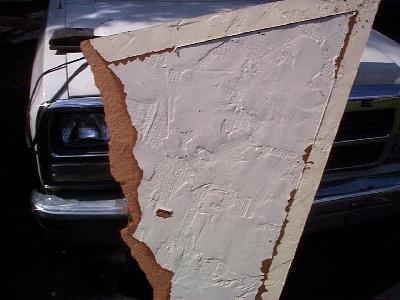Reggie:I have a 17 year old Tudor
in Pittsburgh,
PA that just exposed water damage on one side of the house. It
appears
the construction is stucco coating, over OSB board, over heavy mil
plastic
sheeting, over a foil wrapped board and onto wall studs. The
framing
is stained cedar. The leakage is migrating out from a horizontal cedar
board and to the surface of the stucco. My guess is that the seam
between OSB boards lies under the cedar board. The framing has no
caulking and no flashing. I do not see any mesh, definitely no
metal
mesh.
1. What is the foil board?
2. What options are available to upgrade this construction to
a
more durable one and hold same thickness to match window depth?
3. Is caulking between framing and stucco recommended?
4. Is some kind of flashing recommended, if so describe type?
5. Can this be an insurance claim, eg. are there any known
construction uses that have had historical
claims?
6. What to do about other sides of the house?7. What is Tyvek
wrap?
8. Are pre-stucco panels available to buy and recommended to
use?
Finish is skip-trowel pattern.
What you may have is a material that came out
about
17 years ago and was an early
form of synthetic stucco.
I have only seen this once and
had someone write me
from North Carolina that had this
on his house.
It was applied to the foil covered
foam sheathing.
This material came in bags and
was mixed with a
drill and applied to the foil
sheathing. The house we worked
on was an owner built tudor style
house in Alexandria.
We stuccoed a stair tower that
was started years before
and never finished. We used lath
and stucco, of course.
The then current owners showed
me the leftover bags
with instructions on how to put
it on foil-backed sheathing.
I required no lath. The owner
put it on real rough and painted it white.
I don't remember who made this
stuff and have only
heard of it twice.

Masonite-another
form
of
fake
stucco
Another material you may have are the pre-made stucco
boards
you referred to. These were used
on a lot of tudor style houses
in the last 30 years. They are
masonite(see attachment) and
I think they quit making them
after the lawsuits over masonite siding.
MASONITE I copied this from Here
Masonite Hard Board - (Masonite) - did have a class action suit filed.
The hard board siding was not used a great deal in the Pacific
Northwest
but you do find it from time to time. Most of the Masonite hard board
siding
came in panel form. On expensive
homes you might find the Masonite "clad board". This is where Masonite
covered the hard board siding with a "stucco" appearing material. This
material was used on houses where people wanted to have a "tudor"
looking
home. If you have Masonite
Hard Board siding you may call their claim line at
1-800-330-2722.
Here is a picture of a
piece we
tore of a 15 year old house.
We pulled it off with our
fingers.
Even if they still made
this I
doubt you would want this stuff on
your house, if you knew what it
was. It has about the strength of
cardboard. Still, you may have
it and probably can file a claim
with the manufacturer.
Ideally a tudor house
should have
a flashing over every
horizontal member. Most people
elect not to do this
due to appearance. You honestly
can only see 1/4"
of the flashing and usually these
are so high off the ground
you can't even see them unless
you really stare.
We are getting ready to stucco
an addition to
match an existing house where
the tudor boards were never
flashed. You can see where the
paint is peeling and the boards
are probably rotting. I should
insist that they be flashed first
to protect the stucco.
Assuming the house has
real stucco:
These boards( the horizontal ones
only) can be flashed
properly if you cut off part of
the stucco over the
board a few inches to nail the
flashing tight to the sheathing.
Then the stucco needs to be
patched
to overlap the sheathing.
If you go to this extreme, you
may want to do the entire panels
so the patch doesn't show.
You can get pre-made flashing
at Home Cheapo for about $2.50
A 10 foot length.
Yes, you should have caulking,
but caulking shouldn't be relied
on 100% to keep the house from
leaking.
Tyvek is a plastic vapor barrier
applied to sheathing, like tar-paper.
I like tar-paper better.
If this is Masonite or
the stuff
applied over foil board you can
upgrade to real lath and stucco.
Pittsburgh has a reputation for
good plasterers and I'm sure you
can find someone in your area.
Hope this all makes
sense.
|
